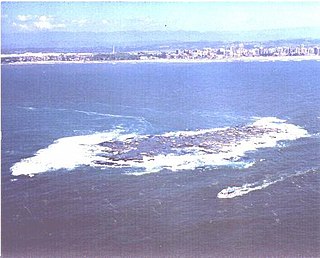
Ilha dos Lobos is a small island and wildlife refuge on the Atlantic coast of Torres, Rio Grande do Sul, Brazil.

Trairão is a municipality in the state of Pará in the Northern region of Brazil.
Academic ranks in Portugal and Brazil are the titles, relative importance and power of professors, researchers, and administrative personnel held in academia.

A Wildlife refuge in Brazil is a type of strictly protected area of Brazil defined by law. The purpose of the wildlife refuge is to ensure survival or reproduction of a species or community of flora or fauna, with access rules defined by the administrative agency.

A biological reserve in Brazil is a legally defined type of protected area of Brazil, a conservation unit that aims for full preservation of biota and other natural attributes without human interference. It may be visited only with prior approval of the responsible agency, and only for research or educational purposes.

National Parks are a legally-defined type of protected area of Brazil. The first parks were created in the 1930s, and other parks were gradually added, typically protecting a natural monument such as a waterfall or gorge near to a coastal population centre. At least two early parks were later submerged by hydroelectric reservoirs. The first park in the Amazon rainforest was inaugurated in 1974. Today the national parks cover a huge area, particularly in the Amazon. However, many of them suffer from outstanding claims for compensation from former owners or users of the land, and many lack the management plans, physical infrastructure and personnel needed to support public visits. The responsible government agency does not have the capacity to provide services such as food and drink, souvenir sales and guided tours, and bureaucracy has delayed letting the private sector bid on providing such services.

A national forest in Brazil is a type of sustainable use protected area. The primary purpose is sustainable exploitation of the forest, subject to various limits. These include a requirement to preserve at least 50% of the original forest, to preserve forest along watercourses and on steep slopes, and so on. More than 10% of the Amazon rainforest is protected by national forests or other types of conservation unit.

A state park in Brazil is a legally defined type of protected area operated by one of the states. Their goal is to preserve important or beautiful natural ecosystems. Public access is allowed subject to regulations defined by the responsible agency.

The Rio São Francisco Natural Monument is a natural monument in the states of Alagoas, Bahia and Sergipe, Brazil. It protects a section of dramatic canyons on the São Francisco River and the surrounding caatinga environment, while supporting tourism and ecotourism.

Itaituba II National Forest is a national forest in the state of Pará, Brazil.

Itaituba I National Forest is a national forest in the state of Pará, Brazil.

The Aripuanã National Forest is a national forest in the state of Amazonas, Brazil. It supports sustainable forestry, and also protects the environment, supports scientific research and protects the sustainable lifestyle of the traditional inhabitants of the forest.

The Rio da Casca Ecological Station is an ecological station in the state of Mato Grosso, Brazil. It protects a partly deforested area of savanna.

The Serra de Santa Bárbara State Park is a state park in the state of Mato Grosso, Brazil. It preserves a unique environment where the Amazon rainforest, pantanal and cerrado meet, and holds many endemic or endangered species.

The Rio Madeira Sustainable Yield Forest is a set of managed forests in the state of Rondônia, Brazil. Three sectors, A, B and C, were created in 1990 but only sectors B and C remain. The forests have not been managed in a sustainable manner.

The Purus National Forest is a national forest in the state of Amazonas, Brazil. It surrounds the shamanic-Christian community of Céu do Mapiá.
A municipal nature park in Brazil is a type of protected area operated by one of the municipalities. Their goal is to preserve important or beautiful natural ecosystems. Public access is allowed subject to regulations defined by the responsible agency.

The Tefé National Forest is a national forest in Amazonas, Brazil. It protects a relatively well-preserved area of Amazon rainforest to the south of the town of Tefé on the Solimões River . The resident population, scattered in small communities along the rivers, are engaged in sustainable farming, fishing and extraction of forest products.

The Pau-Rosa National Forest is a national forest in the state of Amazonas, Brazil.

The Jaci Paraná Extractive Reserve is an Extractive reserve in the state of Rondônia, Brazil. The traditional population is engaged in sustainable use of natural forest resources. It has been subject to illegal invasions by loggers and farmers. In 2014 an attempt was made to revoke the reserve.








